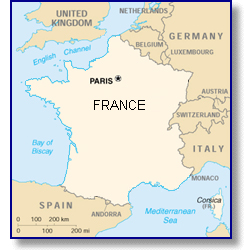 Destination France:
Destination France:
Caoutchouc Artificiel
< Back | Main menu | PSLC | Next >
A quick trip across the English Channel and we are in France: the land of wine, cheese, and rubber chemists. It's 1879, and Sir Henry Wickham has just brought a bunch of rubber tree seeds out of the Amazon. The seeds are growing and England is on the verge of being a major power in the rubber trade. England and France have never been really close friends. In fact, they have been bitter rivals since medieval times. So it's not hard to imagine that the French might not want to have to buy all their rubber from England. A chemist by the name of Gustave Bouchardat was working on a project to avoid such a condition.
Bouchardat, like Williams across the Channel, was working with isoprene isolated from natural rubber, but instead of leaving a bunch of the chemical open to the air, Gustave mixed isoprene with concentrated hydrochloric acid, sealed the mixture in a tube, and heated the mixture for 20 hours. After distillation of the viscous product, a solid product remained. Bouchardat said that this product had "the elasticity and other properties of rubber itself."
This was a great discovery! By adding a concentrated acid, the conversion of isoprene into caoutchouc artificiel, or artificial rubber, was speeded up a lot. This gave the English and Germans something else to argue about. The Germans insisted that it was impossible to produce rubber by this method. The British, on the other hand, confirmed Bourchardat's results in the following years. One English chemist, Sir William Augustus Tilden, even improved on Bourchardat's work, but that's another story.
-
Next stop: Great Britain - Turpentine
Meanwhile...
-
While Bouchardat is speeding up the polymerization of isoprene . . .
the Anglo-Zulu War is taking place in South Africa.Albert Einstein is born.
Thomas A. Edison perfects the incandescent light bulb.
Fyodor Dostoevsky is writing The Brothers Karamazov.
References
1. Barron, Harry. Modern Synthetic Rubbers, 3rd ed. London: Chapman & Hall, Ltd., 1949.
2. Herbert, Vernon and Attilio Bisio. Synthetic Rubber: A Project That Had to Succeed. Westport, Connecticut: Greenwood Press, 1985.
3. Wolf, Howard and Ralph. Rubber: A Story of Glory and Greed. New York: Covici, Friede, 1936.
and the Chemical Heritage Foundation
